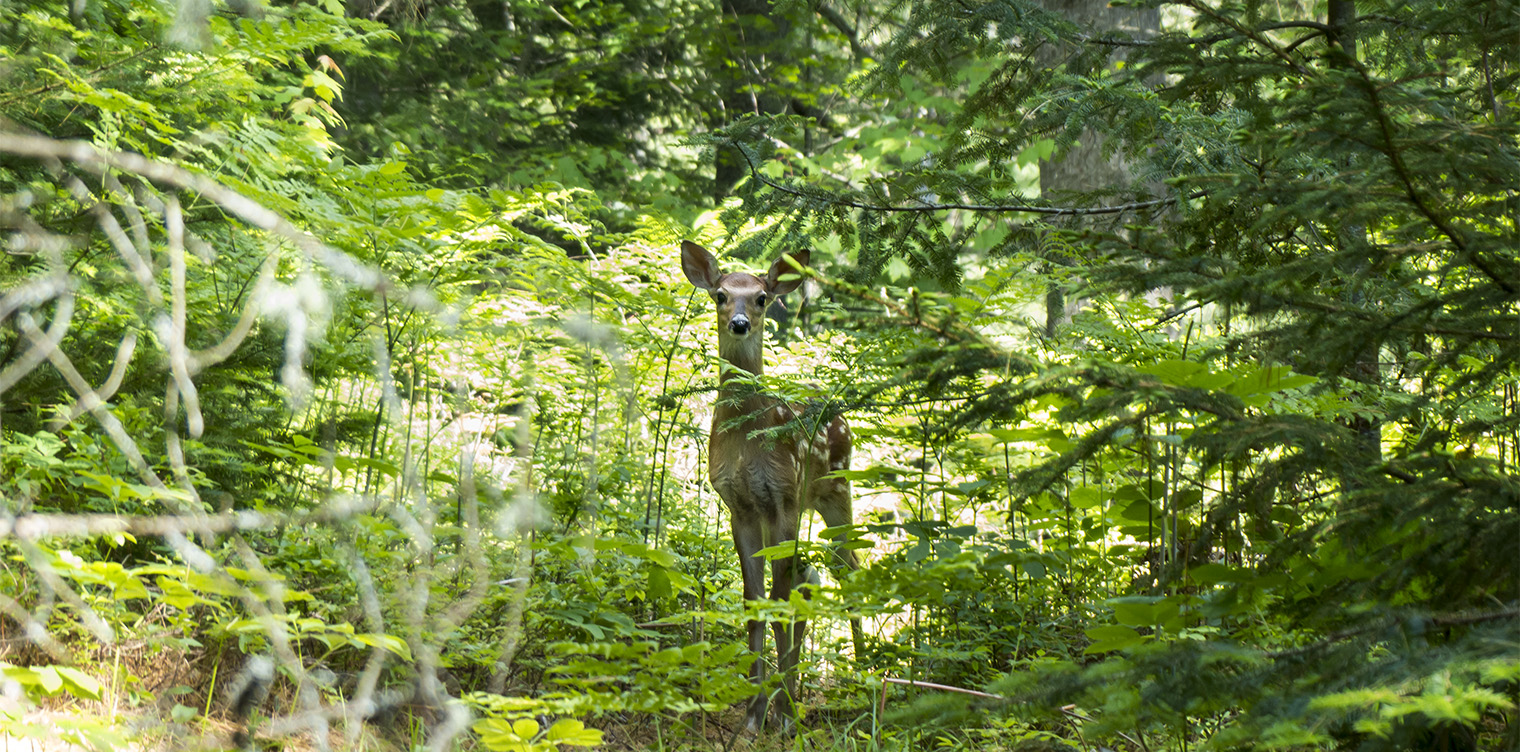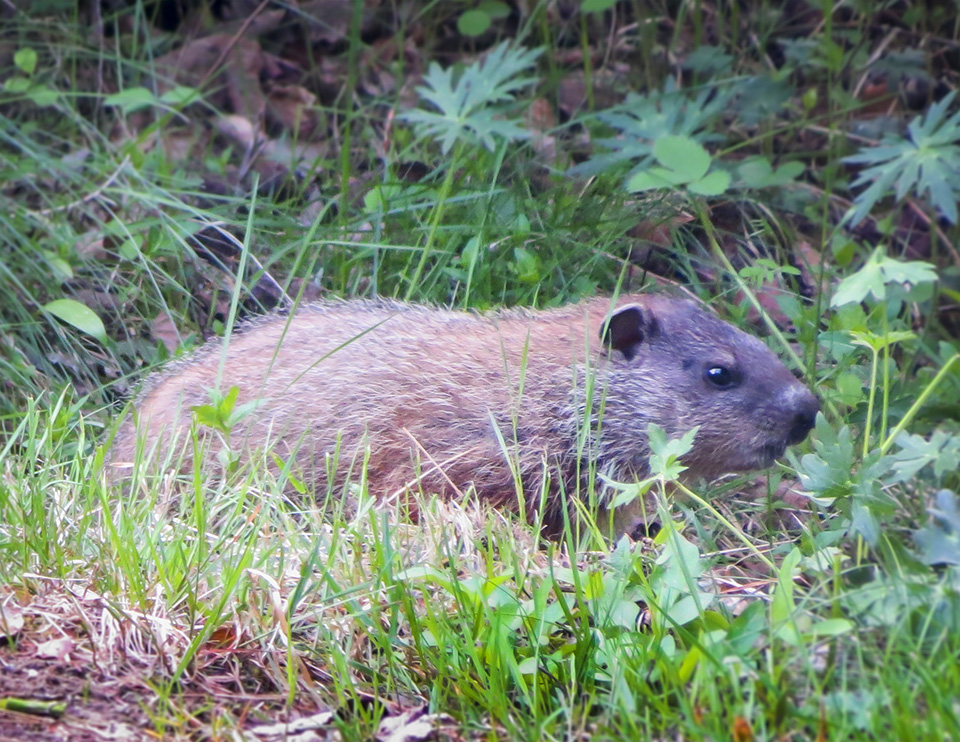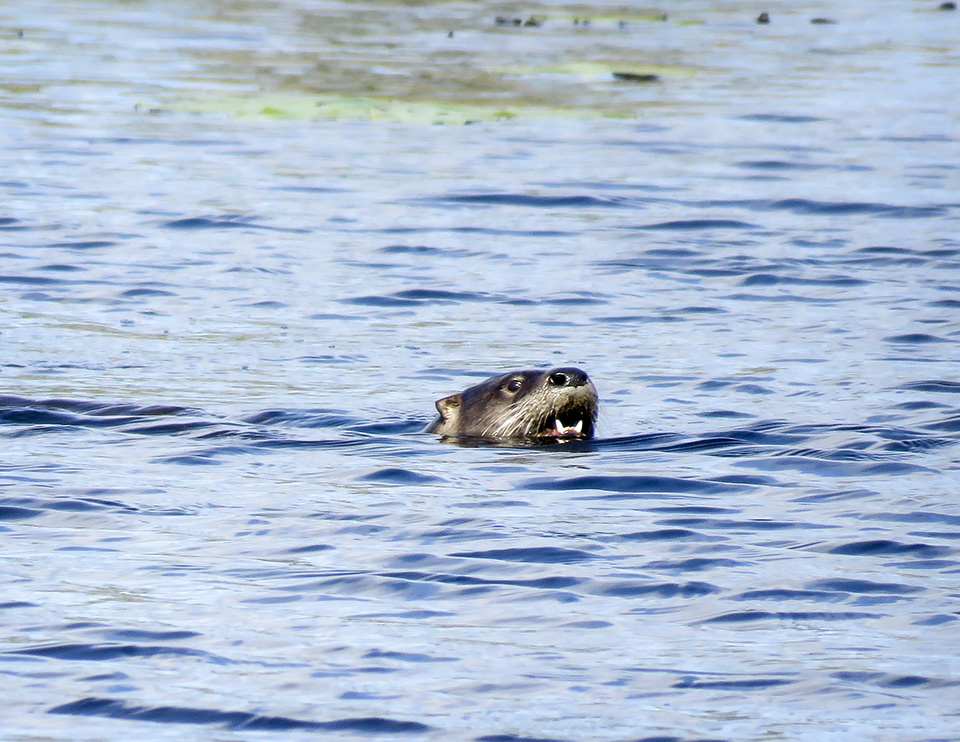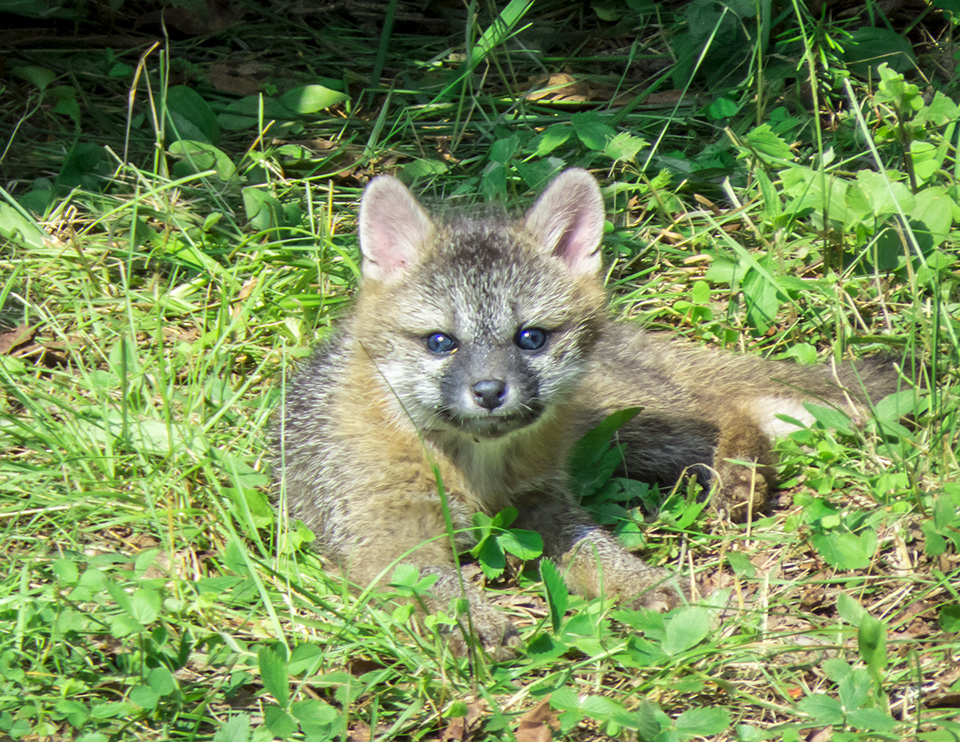Adirondack Wildlife:
Mammals of the Adirondack Park

The list of 53 mammalian species that live in the Adirondacks includes animals found in a wide range of habitats, from the edges of lakes, ponds, and wetlands to northern hardwood, conifer, and mixed wood forests to old fields or early successional sites.
- Some of our mammals are at the northern end of their climactic range. Examples include the Virginia Opossum, the Adirondack Park's only marsupial. This opportunistic omnivore is found mainly in the Southern Adirondacks and around the periphery of the Adirondack Park.
- Other mammals are at the southern end of their climactic range. Examples include the Moose, Fisher, and Ermine.
- Still other mammals that live in our area are found throughout the eastern United States. Examples include the White-tailed Deer, American Black Bear, Raccoon, and American Beaver.
Adirondack Mammals: Herbivores
Adirondack Herbivores
- American Beaver (Castor canadensis)
- Eastern Cottontail (Sylvilagus floridanus)
- Eastern Meadow Vole (Microtus pennsylvanicus)
- Moose (Alces americanus)
- Porcupine (Erethizon dorsatum)
- Snowshoe Hare (Lepus americanus Erxleben)
- White-tailed Deer (Odocoileus virginianus Miller)
- Woodchuck (Marmota monax Erxleben)
Some of the mammals found in the Adirondack region are exclusively or almost exclusively herbivores. Both members of the deer family who live here – Moose and White-tailed Deer – are herbivores.
The Moose (Alces americanus) has the double distinction of being the largest member of the deer family, as well as the largest land mammal in New York State. Moose occur in boreal forest areas in the Northern Hemisphere. Their range includes Alaska eastward to the Atlantic Ocean and south into the Rocky Mountains, northern Great Lakes, and the northeast.
- In the Adirondacks, the Moose represents the reappearance of a species once lost. By the mid-1800s, the moose had virtually disappeared from the area, where it had once been an integral part of the wildlife. Moose began reappearing in New York State in the 1980s. In 2018, biologists estimated that there were about 400 moose in the state.
- Moose diet includes leaves, twigs, and buds of hardwood trees and conifers, as well as shrubs. Their menu includes willows, aspens, birches, alder, maples, dogwoods, cherries, American Yew, Balsam Fir, Northern White Cedar, and Eastern Hemlock. This species also feeds on aquatic plants in wetlands and ponds. An adult moose consumes 40 to 60 pounds of browse daily.
The other member of the deer family – the White-tailed Deer (Odocoileus virginianus Miller) – has a much broader range.
- The White-tailed Deer is found from southern Canada throughout most of the US, southward to northern South America, and inhabits a wide range of habitats from north-temperate to subtropical and semi-arid environments in North America.
- White-tailed Deer were not common in the Adirondack Mountains until about the mid-19th century, when the disturbances associated with human settlement and resource exploitation – agriculture, logging, and the fires which followed – created a habitat more suited to a species which is most at home in forest edges, brushy fields, and the early successional stages of forests.
A selective herbivore, the White-tailed Deer browses on the most nutritious plants available. Its preferred foods include Yew, Hobblebush, Apple, Flowering Dogwood, Alternate-leaved Dogwood, Mountain Maple, and other maples. In the summer, White-tailed Deer also feed on terrestrial and aquatic herbaceous plants, fungi, and fruits. Their autumn and early winter diet includes woody browse (particularly Northern White Cedar), acorns, and beechnuts, plus dried leaves and grasses.

Another herbivore which prefers woodland edges, fields, and meadows is the Woodchuck (Marmota monax) – the largest member of the squirrel family in the Adirondacks. Its range includes most of Canada, east-central Alaska, and much of the eastern half of the United States, with the exception of parts of the South and Southeast.
- The bulk of the Woodchuck's diet consists of herbaceous plants. Its preferred menu includes clovers, grasses, dandelions, goldenrods, and garden crops such as corn and lettuce. Woodchucks also eat berries and the buds of some deciduous shrubs. Although they may consume some insects, animal foods make up less than one percent of their diet.
- During the summer, Woodchucks forage early in the morning and late in the afternoon. In the spring and fall, they are more likely to be active at mid-day. Woodchucks can consume up to 1.5 pounds of vegetation per day. They need to put on enough weight during the warmer seasons to sustain them through winter hibernation, when they lose about 30-40 percent of their body weight while hibernating.
Another herbivore, with a somewhat different survival strategy, is the Snowshoe Hare (Lepus americanus) – the only "rabbit" found throughout much of the Adirondack Park. The name derives from the dense, long hairs which cover the soles of their hind feet, creating "snowshoes" which help them travel over deep snow in winter.
- Part of the Snowshoe Hare's survival strategy involves the choice of habitat; Snowshoe Hares prefer conifer stands where the trees are tall enough to provide protection from avian predators such as owls, but dense enough to offer protection from terrestrial predators such as Eastern Coyotes.
- Another Snowshoe Hare survival strategy involves a color change to maximize camouflage. From mid-December until late April, the Snowshoe Hare's fur is mainly white. In the summer, its coat is yellowish to cinnamon brown above; the chin, tail, and lower parts are white to grayish white, and the ears are tipped with black. The seasonal color change takes place over a period of about 70 days.
Snowshoe Hare populations in New York State (including the Adirondack region) are declining, apparently due to changes in the timing and duration of snow pack, which may impede the hare's effectiveness at evading predation.
Adirondack Mammals: Carnivores
Adirondack Carnivores
- American Mink (Neovison vison)
- Big Brown Bat (Eptesicus fuscus)
- Bobcat (Lynx rufus)
- Eastern Red Bat (Lasiurus borealis)
- Eastern Small-footed Myotis (Myotis leibii)
- Ermine (Mustela erminea)
- Hairy-tailed Mole (Parascalops breweri)
- Little Brown Myotis (Myotis lucifugus)
- Long-tailed or Rock Shrew (Sorex dispar)
- Long-tailed Weasel (Mustela frenata)
- North American River Otter (Lontra canadensis)
- Silver-haired Bat (Lasionycteris noctivagans)
- Star-nosed Mole (Condylura cristata)
At the other end of the spectrum are animals who are exclusively or almost exclusively carnivorous. This list includes a number of insectivorous bat species which make their home in the Adirondacks, such as the Big Brown Bat and the Silver-hared Bat.
Another Adirondack carnivore is the Bobcat (Lynx rufus), the only member of the cat family living in the Adirondacks since the Canadian Lynx became extinct in this region in the 1800s. The Bobcat is the most widely distributed native cat in North America. Its range includes southern Canada and most of the United States and Mexico.
- Habitats that Bobcats prefer include shrubby fields, wooded farmland, lowland conifer, and mixed or deciduous woods. In the Adirondacks, the Bobcat is most common at low to mid-elevations.
- White-tailed Deer, Eastern Cottontail, and Snowshoe Hare are the most common items in the Bobcat's diet. Bobcats may also consume opportunistic prey items, such as birds, squirrels, voles, and road kill. Although almost exclusively carnivorous, on rare occasions the Bobcat may also consume fruit.

Another carnivorous mammal with a relatively wide distribution is the North American River Otter (Lontra canadensis). This species occurs in much of Canada and the United States, except for portions of the Southwest. Its habitat, however, is very different from that of the Bobcat, since the otter is a semi-aquatic animal which makes its home in rivers, lakes, ponds, small streams, marshes, and other inland wetlands. North American River Otters are often found in the same freshwater wetlands as beaver.
A member of the Weasel family, North American River Otters are carnivores and will consume almost anything they can catch. Fish comprise the majority of their diet, but they will also take crustaceans and other aquatic invertebrates. North American River Otters have also been known to kill and eat birds and mammals, especially young beavers and muskrats.
North American River Otters are primarily visual predators. However, they also have motion-sensitive whiskers which enable them to forage in murky waters and find their prey by sensing vibrations with their whiskers.
Adirondack Mammals: Omnivores
Adirondack Omnivores
- American Black Bear (Ursus americanus)
- American Marten (Martes americana)
- Deer Mouse (Peromyscus maniculatus)
- Eastern Chipmunk (Tamias striatus)
- Eastern Coyote (Canis latrans var)
- Gray Squirrel (Sciurus carolinensis)
- Fisher (Martes pennanti)
- Gray Fox (Urocyon cinereoargenteus)
- Muskrat (Ondatra zibethicus)
- Raccoon (Procyon lotor)
- Red Fox (Vulpes vulpes)
- Red Squirrel (Tamiasciurus hudsonicus)
- Striped Skunk (Mephitis mephitis)
- Virginia Opossum (Didelphis virginiana)
Many of our Adirondack mammals are less fussy about their diet, opportunistically eating both plants and animals. These include a number of mammals that we often think of as plant eaters, such as the Eastern Chipmunk (Tamias striatus) and Red Squirrel (Tamiasciurus hudsonicus) – both renowned as consumers of nuts and seeds. However, both species may be classified as omnivorous, because both consume insects, young birds, and bird eggs.
The list of Adirondack omnivores also includes mammals in the order Carnivora, such as the American Black Bear (Ursus americanus).
- The American Black Bear's range includes much of Canada, except the southern prairie provinces and Prince Edward Island. In the United States, this species is found in the Pacific Northwest, the northern Rocky Mountains, the Southwest, the northern Great Lakes, New England, New York, in the Appalachians to northern Georgia, Ozark Mountains, the Piedmont region, Florida, and the Gulf Coast.
- In New York State, about half of the state's estimated 6,000 to 8,000 American Black Bears live in the Adirondack Mountains.
American Black Bears eat a varied diet, including at least thirty different plant species and many different types of nonplant matrial.
- This species eats insects, fish, small mammals, and any other animals it can capture, including White-tailed Deer fawns.
- In the spring, when food is scarce, American Black Bears consume aspen catkins, succulent grasses, tender young shoots and leaves, and fern fiddle heads.
- Later in the season, the bear menu expands to include berries and other fleshy fruits, as well as acorns and beech nuts.

The Gray Fox (Urocyon cinereoargenteus) is another opportunistic omnivore. The Gray Fox can be distinguished from the Red Fox by coloration. Gray Foxes have a black-tipped tail, while Red Foxes have a white-tipped tail.
The Gray Fox ranges from the southern portions of eastern Canada south to the northern tip of South America. This fox prefers deciduous forests and brushy, rocky woodlands, although it will also make its home in mixed wood forests and forest-farmland edges.
An opportunistic omnivore, the Gray Fox consumes more plant food than other foxes do.
- The Gray Fox menu includes small to medium-sized mammals (such as Eastern Cottontails, voles, and mice), birds and their eggs, insects, reptiles and amphibians.
- Gray Foxes also consume plant food, such as large seeds and fruits. Fruits, such as apples, are consumed in the fall.
Unlike the Red Fox, the Gray Fox can climb trees, either to pursue prey or escape danger. This ability allows them to avoid predation by the Eastern Coyote, which reportedly may minimize the effect that Eastern Coyotes have on their population.
Adirondack Mammal List
References
New York State Department of Environmental Conservation. Mammals. Retrieved 13 January 2025.
New York State Department of Environmental Conservation. Moose. Retrieved 13 January 2025.
State University of New York. College of Environmental Science and Forestry. Adirondack Mammals. Retrieved 13 January 2025.
United States Department of Agriculture. Fire Effects Information System (FEIS). Species Reviews. Retrieved 13 January 2025.
Smithsonian National Museum of Natural History. North American Mammals. Retrieved 13 January 2025.
Integrated Taxonomic Information System. Retrieved 13 January 2025.
D. Andrew Saunders. Adirondack Mammals (Adirondack Wildlife Program. State University of New York. College of Environmental Science and Forestry, 1988).
William K. Chapman. Mammals of the Adirondacks. A Field Guide (North Country Books, 1991).
Alexander C. Martin, Herbert S. Zim, and Arnold L. Nelson. American Wildlife & Plants. A Guide to Wildlife Food Habits (Dover Publications, 1951).
James M. Ryan. Adirondack Wildlife. A Field Guide (University of New Hampshire Press, 2008).
Donald W. Stokes and Lillian Q. Stokes. A Guide to Animal Tracking and Behavior (Little, Brown and Company, 1986).
National Geographic Society. Wild Animals of North America (National Geographic Society, 1995).
Adrian Forsyth. Mammals of North America. Temperate and Arctic Regions. (Firefly Books, 1999).
